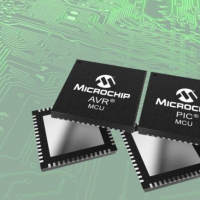Five families of PIC and AVR 8bit microcontrollers launch

Microchip has launched five families of 8bit microcontrollers with 65 new PIC and AVR devices covering 1500 part numbers. Microchip has kept the PIC and AVR core separate, but uses common peripherals with wrappers to ensure pin-to-pin compatibility. The 8bit families include smart peripherals such as a software-controlled op amp.
Microchip has launched five families of 8bit microcontrollers with 65 new PIC and AVR devices covering 1500 part numbers.
Microchip has kept the PIC and AVR core separate, but uses common peripherals with wrappers to ensure pin-to-pin compatibility.
The 8bit families include smart peripherals such as a software-controlled op amp found on the PIC16F171 family as well as the Multi-Voltage I/O (MVIO) and Analog-to-Digital Converter with Computation (ADCC) blocks.
The MVIO allows chips to use different supply voltages, for example connecting a 5V MCU to a 1.8V sensor. This would normally require level-shifting hardware, which increases costs. The level shifter might cost a few cents, but microcontrollers such as the AVR DD family costing as little as 35c, this can be a 10% cost saving, and allows a single port on the MCU to operate in a different voltage domain than the rest of the MCU, which eliminates the need for additional external components.
The ADCC is a Core Independent Peripherals (CIPs) with a 12bit analog to digital converter (ADC) with filtering and averaging. This takes up to 16 samples to average the signal and eliminate any noise, reducing the need for external filters and avoiding the need to use the CPU core.
The CIPs on the PIC and AVR 8bit microcontrollers can be programmed with MPLAB Code Configurator (MCC) to be easily connected to form a hardware processing chain. This makes it possible to create custom peripherals that eliminate software processing cycle times. For example, a WS2812 LED array, which requires unique timing to be driven correctly, can be controlled easily by configuring a super peripheral consisting of a Pulse-Width Modulator (PWM), an SPI interface, and the Configurable Logic Cell (CLC).
“PIC and AVR microcontrollers are incredibly popular because they are designed to meet our clients’ requirements for current, as well as future, applications,” said Greg Robinson, vice president of marketing for Microchip’s MCU8 business unit. “We have also built a robust supply chain for 8-bit PIC and AVR MCUs, the vast majority of which are manufactured in Microchip-owned facilities. This allows us to control the production process in ways that are not common in the industry.”
The 8bit microcontrollers are supported by a development ecosystem of hardware and software tools, including its MPLAB X and MPLAB Xpress Integrated Development Environments (IDEs), as well as the MPLAB Code Configurator (MCC) which offers an intuitive graphical interface to generate production-ready setup and application code for 8-bit MCU-based projects.
